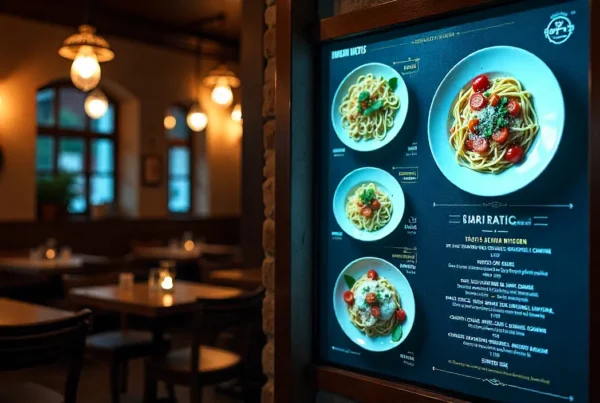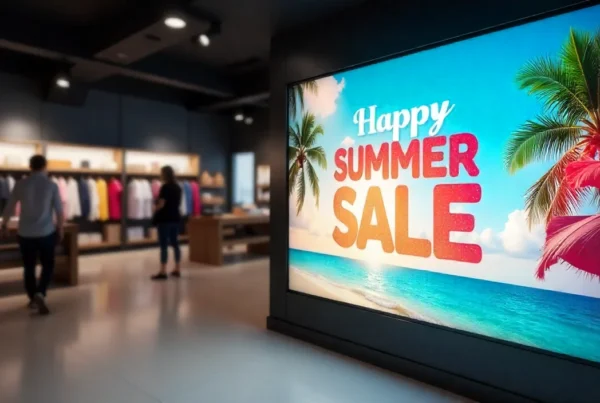In the current high-paced display market, the digital signage player is the driving force that can transform your content strategy into screen reality. It links your CMS to your screens, updates in real time, and maintains a smooth playback, no matter what you are testing (a digital signage player for TV), rolling out (an Android digital signage player), or centralizing (a cloud-based digital signage player).

What is a digital signage player?
When you wonder what a digital signage player is, you can consider it as an interface between your display and your content management system. It caches, processes, and displays videos, images, data dashboards, and interactive layouts on your screens.
Content Playback
Digital signage media players support high-bitrate videos, image carousels, HTML5 widgets, and live feeds to make campaigns look sharp and stutter-free on single displays and video walls.
Remote Management
Digital signage media player software allows you to track device health, push playlists, and roll back changes remotely, which is perfect when operating distributed networks and time-sensitive campaigns.
Scheduling
The rule-based scheduling activates the appropriate creative at the appropriate time—by hour, daypart, location, or audience—to maximize impact without manual control.
Interactivity
Displays become two-way wayfinding, self-service kiosks, and product-discovery experiences using touch, sensors, and external triggers.
Digital Signage Player Categories
1) Hardware Digital Signage Media Player
Purpose-built tuned boxes are designed to be reliable and secure, usually with dedicated digital signage media player software.
Examples: BrightSign, Intel NUC-based players, and AOPEN solutions.
Ideal for: 4K playback, 24/7 uptime, and enterprise security policies.
2) Android Digital Signage Player
An Android digital signage media player is based on Android OS and can utilize Play Store applications or its own APKs. It is convenient to deal with and is highly compatible.
Ideal for: Restaurants, retail, and SMB pilots where fast setupand Wi-Fi/Bluetooth are factors.
3) Digital Signage Cloud-Based Player
These are based on internet connectivity and centralized control and updates. Playback is resilient with local caching of content.
Ideal for multi-site brands, franchises, and corporate communications that have frequent changes.
4) Digital signage player with screen
All-in-one units are integrated player-displays with reduced cabling, quicker installs, and tidy kiosks.
Recommended for: Menu boards, check-in points, and pop-up activations.
5) Digital Signage Player application
On smart TVs, tablets, or PCs, install a digital signage player app to reuse existing hardware and reduce cost.
Ideal use case: Cafes, events, and small footprints that require rapid deployments.
Key Features to Look for in a Digital Signage Player
Display Compatibility
Make sure it supports HD/Full HD/4K (and HDR where necessary). Use matching ports (HDMI/DisplayPort) and check EDID handling to prevent any scaling problems.
Operating System
- Android: Flexibility of the app and ability to make a quick prototype.
- Linux (e.g., BrightSign): Stability and low footprint to serve 24/7.
- Windows: Windows are optimal when it comes to complex integrations, custom apps, and peripheral-intensive kiosks.
Connectivity & I/O
Both fixed and mobile installations are possible with HDMI, USB, Ethernet, Wi-Fi, and Bluetooth. Strong networking provides good syncing and monitoring.
Remote Management & CMS
A digital signage player in the cloud with a mature CMS can support fleet-wide updates, device health monitoring, and failover.
Scheduling & Targeting
Geotargeting and audience-based playlists, as well as time/date rules, are useful to align content with customer intent and store operations.
Security & Reliability
Seek secure boot, encrypted comms, kiosk lockdown, watchdog services, and remote diagnostics to minimize truck rolls and downtime.

Advantages of Digital Signage Player
Enhanced Engagement
Data-driven widgets, motion graphics, and immersive layouts are better than plain posters, attracting more eyes and dwell time.
Cost-Effective Advertising
Reduce print cycles and respond to inventory, pricing, and promos in real time—no reprint delay or distribution fees.
Real-Time Updates
Change playlists between flash sales, events, or emergencies within seconds at a single site or a global network.
Scalability
Control numerous screens and locations in a single dashboard, normalizing content, approvals, and performance monitoring.
Interactive Experiences
NFC/QR paths and touch-enabled Android digital signage player installations make discovery measurable.
How to Choose the Right Digital Signage Player?
The choice of a digital signage player must be based on use case, content weight, and growth plans. Take this short matrix:
| Factor | Consideration |
| Purpose | Retail ads, wayfinding, corporate messaging, dashboards, or interactive kiosks? |
| Budget | Compare dedicated digital signage player hardware to app-based approaches on existing devices. |
| Scalability | Will you expand to multiple screens/sites? Centralized cloud control helps. |
| Content Type | Heavy 4K video, HTML5 dashboards, or mostly images? Match CPU/GPU accordingly. |
| Internet Dependency | Do you need offline playback, or is full cloud-based digital signage player control acceptable? |
Use Cases: TVs to Kiosks
A television digital signage player is ideal when used in a lobby screen and menu board applications where easy scheduling and 4K resolution are important. With kiosks and self-service points, deployment is simplified by a digital signage player with a screen. Your pilots can begin using an app on existing smart TVs and transition to specialized boxes as your network grows.
Build Your Network with Confidence
Before you standardize on digital signage player hardware or prove your value with an Android digital signage player, determine your content mix, operating constraints, and scale objectives. This will then lead to choosing the platform that best fits into your CMS, security policies, and realities in your stores and leave your roadmap open to any future integrations.

Launch Faster, Scale Smarter
Tell us your screen number, content mix, and schedule, and we can tell you what to do next, be it a lightweight digital signage player application to test a pilot or ruggedized hardware to power 24/7 4K. We will align your CMS, your security requirements, and your store realities to ensure that day one is as smooth as possible and your day ninety is as easy to scale as possible.
Whether it is device choice or playlist approach, we will assist you in cutting down on downtime, accelerating update rates, and ensuring content retains its crisp appearance everywhere. Moreover, when you have several sites to manage, we can set up centralized control so you can push changes in minutes and measure impact with confidence.
FAQs: Digital Signage Player
What is a digital signage player?
It is the device or software layer that presents multimedia on your screens and talks to your CMS. It guarantees dependable playback, scheduling, monitoring, and control at a single or multiple sites.
Can I use an Android TV as a digital signage player?
Yes. A digital signage player app should be installed to schedule and update content remotely. A box can be used when the workload is heavier at 4K or when a stricter kiosk mode is required.
What’s the difference between a media player and a digital signage player?
The simple media player plays local files only. A digital signage media player provides an interface, a scheduler, remote management, remote updates, device health, and interactivity, designed to be business ready.
Do I need an internet connection for a digital signage player?
Cloud-managed setups do. Most devices store content to play offline, so displays do not stop when the connection goes down and resync when the connection comes back.
What is the best digital signage player for 4K displays?
The 4K is reliably used in BrightSign, Intel NUC builds, and some commercial smart displays. Your bitrate and layout complexity should match GPU capability and storage speed.
Can I use a Raspberry Pi as a digital signage player?
Yes, when combined with compatible digital signage media player software, Pi can drive simple menus and dashboards. Use higher-spec hardware on demanding video walls.
How do I update content on a digital signage player?
With USB-based local updates, LAN-based on-premises networks, or cloud CMS-based centralized control. Approval workflow and versioning keep teams in a coordinated state.
What’s the advantage of a cloud-based player?
A cloud-based digital signage player provides real-time updates, fleet monitoring, and scalability—it is perfect for brands with numerous locations that change content frequently.
Can a player support touchscreen interactivity?
Yes. There are a lot of Android digital signage players and Windows/Linux boxes that support touch, barcode/RFID, printers, and other peripherals to create strong kiosks.
How long do players last?
Good products last 3-5+ years. Keep them aired, patched, and checked to prolong service life and prevent unscheduled shutdowns.





